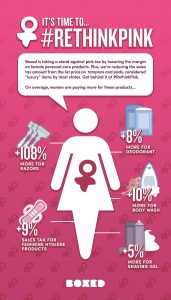
By Samantha Anthony
If you aren’t already passionate about women’s issues, you probably have a friend who is – and that friend has probably told you about the “pink tax.” It might sound like a feminist myth, but a study published by the U.S. Government Accountability Office in August found that in some cases, the issue is very real.
Essentially, the “pink tax” is the name given to the theory that it is more expensive to be a woman due to the higher cost of products geared toward female consumers. Ax The Pink Tax is a website dedicated to bringing awareness to the subject. According to Ax The Pink Tax, the average woman pays an extra $1,351 per year. To back up this claim, the website features a study published by NYC Consumer Affairs, called “From Cradle to Cane: The Cost of Being a Female Consumer.” Women are urged to use the hashtag #AxThePinkTax to share their stories and raise consumer awareness among one another.
While Ax The Pink Tax alleges that women pay a slightly higher percentage for almost everything from adult and children’s clothing to razors and deodorant, the GAO study asserts that this is only sometimes the case. “Of 10 personal care product categories (e.g., deodorants and shaving products) that GAO analyzed, average retail prices paid were significantly higher for women’s products than for men’s in 5 categories,” the GAO states in the report. Additionally, “Studies GAO reviewed found limited evidence of gender price differences for four products or services not differentiated by gender—mortgages, small business credit, auto purchases, and auto repairs. For example, with regard to mortgages, women as a group paid higher average mortgage rates than men, in part due to weaker credit characteristics, such as lower average income.” While the GAO does admit to finding gender-based price differences in consumer products, it allows that there is not “a need to incorporate additional materials specific to gender-related price differences into their existing consumer education resources” (or, in other words, they’re not going to do anything about it). Unfortunately, it seems like the cause of the pink tax is rooted in pay inequality, which is an ongoing issue for women everywhere.
If you’re concerned about the pink tax and how it might impact you, pay close attention to the products that are most susceptible to the pink tax: razors, body wash, shampoo and conditioner, underwear, and toys and accessories. Read the U.S. GAO report and visit AxThePinkTax.com to learn how much money you’ve lost to the pink tax and find out what you can do to stop it.